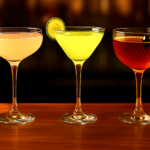
Cocktails!
June 6, 2025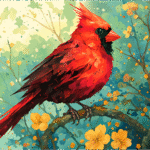
Cardinal (Illustrator)
July 10, 2025
Annotated Beatles UK Discography
In early 2021, as the novelty of working from home during the pandemic was wearing thin, I distracted myself with a personal challenge to dig deeper into Beatles lore and do a series of writeups about their UK album releases. Each day and in chronological order, I listened to one album on repeat while researching tidbits about its production, cultural happenings during the time it was made, and other anecdotes worth noting. I originally posted these one per day on Instagram, but recently it dawned on me that compiling them into a single list would make them easier to digest. Here you go:
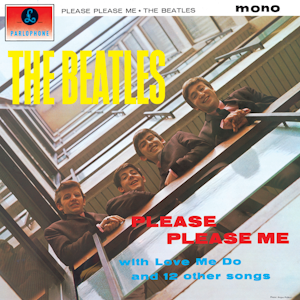
PLEASE PLEASE ME | Released March 22, 1963
Recorded in a marathon 13-hour session in Studio 2 at Abbey Road, the album was quickly put together to capitalize on the success of the singles “Love Me Do” and “Please Please Me.” It was essentially the band’s live setlist at the time, and they reportedly even considered recording it live at the Cavern Club before opting for the studio. The session cost was about £400, and each Beatle was paid £7.50. John Lennon had a cold, so producer George Martin left the recording of “Twist and Shout” for the end of the session, out of concern that it would trash his vocal cords for the rest of the day. He nailed it on the first take (The band did record a second take, but the first one was selected for the album). Tune In writer and historian Mark Lewisohn wrote “There can scarcely have been 585 more productive minutes in the history of recorded music”.
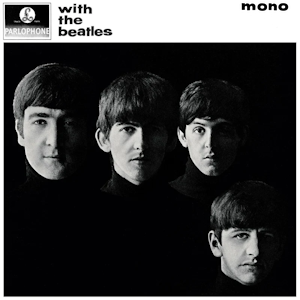
WITH THE BEATLES | Released November 22, 1963
Recorded over seven sessions from July through October 1963. Interestingly none of the tracks were released as singles in the UK. The cover was shot by Robert Freeman – inspired partly by his photos of John Coltrane, as well as Astrid Kirchherr’s photos of the Beatles taken during their Hamburg days – and marked the beginning of his long relationship with the band. This was also (sort of) the first US album released by Capitol, though it was retitled “Meet the Beatles!” in the US, and featured a modified track list (12 tracks vs 14 on the UK version, and included their hits “I Wanna Hold Your Hand” and “I Saw Her Standing There”), with nine tracks in common.

A HARD DAY'S NIGHT | Released July 10, 1964
This was the first Beatles album to feature all original compositions, and the only album written exclusively by Lennon and McCartney. The album’s title is a Ringo-ism, a malapropism he uttered following an all-night recording session. All the tracks on Side 1 are featured in the film of the same name, which by the way if you haven’t seen, is pretty amazing – it’s not a documentary, but mirrors their frantic lives at the absolute peak of Beatlemania, and reflects the camaraderie, wit and appeal that made them a sensation.

BEATLES FOR SALE | Released December 4, 1964
Hindsight being 20/20, the album both visually and musically seems emblematic of the band’s state of mind at the time; the novelty of Beatlemania was wearing thin, and the constant touring had exhausted them. To top it off, it was produced less than six months after their previous release (Help), and was their fourth release in 21 months. To meet the demand, the album is sprinkled with cover songs taken from their live setlist, including Chuck Berry’s “Rock and Roll Music” and Buddy Holly’s “Words of Love.” Nonetheless, it is loaded with musical gems, and McCartney has stated that it marked a period of growth for the band: “We got more and more free to get into ourselves. Our student selves rather than ‘we must please the girls and make money’…”

HELP! | Released August 6, 1965
This was the second Beatles album to accompany a feature film of the same name, part of a three-picture deal with UA. Regarding the title track, John Lennon has described the time as his “fat Elvis period”: “It was just me singing ‘Help’ and I meant it…and it makes me feel secure to know that I was aware of myself then.” Ringo’s “Act Naturally” was the last cover song the band would record until “Maggie Mae” on “Let it Be.” Also TIL: I had always assumed they were spelling out H-E-L-P in flag semaphore on the cover, but they’re actually signing N-U-J-V; the photographer wasn’t happy with the arm arrangements, so had them change their poses to something that would look better on the cover.

RUBBER SOUL | Released December 3, 1965
The start of my favorite era on the Beatles timeline (not saying their previous or subsequent efforts were sub-par!). Most of the songs were composed after the band returned to London from their North American tour, and reflects the influence of Motown, Dylan, the Byrds, and other aspects of American pop culture on their work. Charles Front’s cover logo was designed to mirror the distortion in Robert Freeman’s photo, and was influential on other poster art of the era. Brian Wilson said the album inspired The Beach Boys to make “Pet Sounds”: “‘Rubber Soul’ blew my mind…I said ‘That’s it’…I’m going to make an album that’s really good, I mean really challenge me….” Confusingly, four of the fourteen tracks were removed from the US version by Capitol and instead included on “Yesterday and Today,” which featured the infamous “Butcher Cover.” Also, road manager Mal Evans is credited for playing Hammond organ on “You Won’t See Me.”

REVOLVER | Released August 5, 1966
This has been my favorite album since high school, from the first time I remember hearing Harrison’s politically-tinged “Taxman,” followed by “Eleanor Rigby” on side one, and everything amazing that followed. Speaking of “Taxman,” the lyric “…there’s one for you nineteen for me” was an accurate depiction of the 95% tax(!) the Beatles were levied for their income bracket at the time. Cover artist Klaus Voormann was paid about £40 – £50 for his work, which won a Grammy for Best Album Cover. It was the first album to feature backwards guitar (on “I’m Only Sleeping”), and yes, “Got to Get You Into My Life” is McCartney’s ode to pot. Although the Beatles began a 14-day US tour just four days after the album’s release (their last tour ever), none of the songs were ever played live, as the band felt it would be too difficult to reproduce the technical sophistication of the studio recordings on stage.
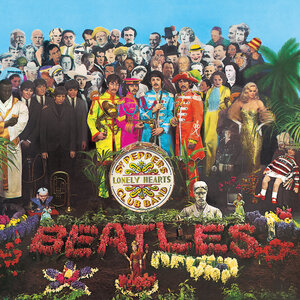
SGT. PEPPER'S LONELY HEARTS CLUB BAND | Released May 26, 1967
What can I say that hasn’t already been said? From its iconic album cover with the lyrics on the back (a first), to the sheer abundance of sonic experimentation, the album was a cultural and artistic watershed, and influenced countless others in its wake. You may already know that the album’s theme and title came to McCartney during a flight to London, but did you know that despite its heights, no singles from it were released? “Penny Lane” was recorded during the same sessions and did hit #1, but it was released as a single and not included on the album. On “With a Little Help From My Friends,” Ringo was supposed to sing “…would you stand up and throw tomatoes at me?,” but adamantly refused out of concern that fans would take up the challenge, so the lyric was rewritten. Producer extraordinaire George Martin also played five instruments on different tracks – fifth Beatle indeed. The album spent 27 consecutive weeks at #1 in the UK. Whew.
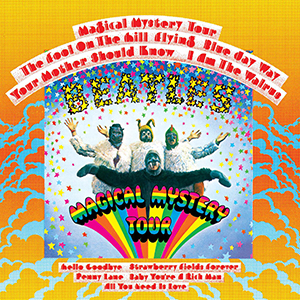
MAGICAL MYSTERY TOUR | Released November 27, 1967
The eleven-track US album preceded the UK six-track double EP release by more than a week; the UK version of the full album was not released until 1976. Despite widespread criticism of the accompanying film (which incidentally didn’t fulfill UA’s 3-picture agreement, since it was made for TV), the soundtrack was a critical and commercial success, topping both the UK EP chart and Billboard’s album chart in the US. “I am the Walrus” was inspired by Lewis Carroll as well as Lennon’s experimentation with LSD; it’s claimed that the two-note pattern that opens the song was based on a siren sound he heard while tripping, and is also echoed in the rhythm and melody of “Mister City, policeman sitting.” Oh, and for the record, the walrus was John – or was it Paul?. References in the accompanying 24-page booklet of Paul wearing a black rose, and seated behind a sign reading “I WaS,” later fed in to the “Paul is dead” myth.
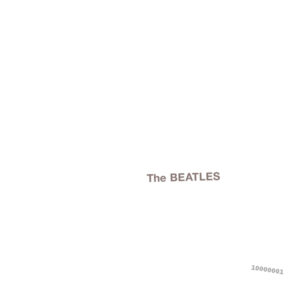
THE BEATLES (WHITE ALBUM) | Released November 22, 1968
The first album release on the band’s own Apple label. Earlier issues were numbered until early 1971. Most of the songs were conceived during the band’s 1968 trip to Rishikesh, India. By the end of the year, over 4 million copies were sold, and it was the biggest selling double album ever at the time. George Martin was initially against the idea of a double album, and suggested reducing the number of songs to fit a single disc but the band refused. The album marks a period fraught with discord, particularly between McCartney and Lennon over philosophical and creative differences, and Ringo even quit for two weeks before being persuaded to rejoin. Members were composing tracks almost exclusively on their own, in fact only 16 of the album’s 30 tracks feature all four performing. Also TIL: I knew that Clapton played guitar on “While My Guitar Gently Weeps” but I didn’t know that Harrison’s “Savoy Truffle” was inspired by Clapton’s fondness for the chocolate treat.
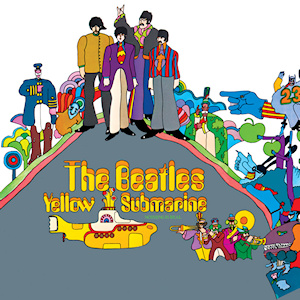
YELLOW SUBMARINE | Released January 13, 1969
This album is regarded by many as the least essential release of the Beatles discography. The four new original tracks were actually recorded before the “White Album,” to fulfill their final film obligation with UA. The other two Beatles songs (Yellow Submarine” and “All You Need is Love”) were taken from previous recordings, and side 2 is all instrumental, written mainly by producer George Martin, and performed by a 41-piece orchestra. It’s well known that the Beatles didn’t voice their own characters in the film, but I didn’t know that the script was originally written by a team of American writers, and subsequently tweaked so that their dialog would sound more authentically Liverpudlian.

ABBEY ROAD | Released September 26, 1969
BT’s favorite. The album was actually recorded after but released before “Let It Be,” and George Martin had to be convinced to return for its production, and on the condition that he would have full control. And speaking of convincing, Ringo wasn’t keen on doing a drum solo for “The End,” but came around because he knew it would probably be their last record. And the song’s three-part guitar solo – played in order by Paul, George and John – was recorded live in a single take. Photographer Iain Macmillan had just ten minutes to shoot the iconic cover, standing on a stepladder while police held up traffic, and produced just six photos for the band to choose from. Perspective is a funny thing: Abbey Road originally received mixed (and even scathing) reviews, but over time has become regarded as one of their best efforts, as evidenced by its high ranking on many all-time best album lists.
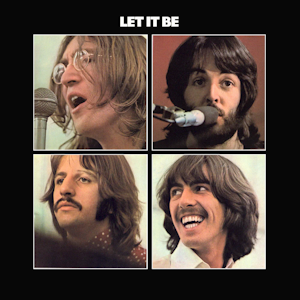
LET IT BE | Released May 8, 1970
Originally titled “Get Back,” the album was the band’s attempt to eschew overproduction and return to their roots and a more stripped down sound. They even considered recording it in front of a live audience, on a boat middle of the ocean, and even in the Tunisian desert. Relationships within the group had frayed nearly to the point of no return, and no one wanted to sort through the hundreds of hours of recordings, so the project was shelved for more than a year. Phil Spector was brought in to finish the production, and although the “wall of sound” producer’s final product was especially disliked by McCartney and producer Martin, Lennon defended his effort: “…he was given the shittiest load of badly recorded shit with a lousy feeling to it ever, and he made something out of it. He did a great job.” The photo originally intended for the cover, Angus McBean’s updated recreation of his “Please Please Me” cover taken on the EMI House balcony, was scrapped for the album but ultimately used for the band’s “1967-1970” compilation (aka The Blue Album).
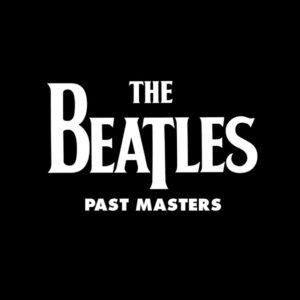
PAST MASTERS | Released March 7, 1988
Although this two-volume collection came out 18 years after the Beatles split up, it’s an essential part of their catalog, since it includes every* commercially released song that wasn’t included on their other albums. One rationale I read for their omission was that producer George Martin didn’t want fans who bought the singles to have to pay again for the same songs on the albums (at least for the UK versions).
*You would still have to add Free as a Bird, Real Love and Now and Then to own everything the Beatles have released commercially, since since the first two songs didn’t come out until the Anthology release in 1996, and Now and Then was released in November 2023.